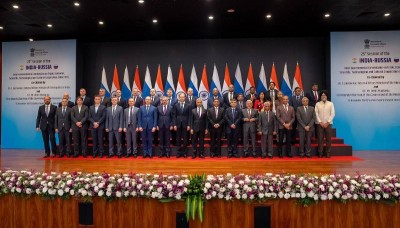 North East
North East
Northeast: AFSPA - Shrinking Scope
The Union Ministry of Home Affairs (UMHA) in a release dated March 31, 2022, announced now AFSPA [Armed Forces Special Powers Act] is being removed with effect from 01.04.2022 [April 1, 2022] completely from 23 districts and partially from 1 district of Assam.
"15 police station areas of 6 districts of Manipur will be excluded from the Disturbed Area Notification [under AFSPA] with effect from 01.04.2022… The Disturbed Area Notification is being withdrawn from 15 police stations in 7 districts in Nagaland with effect from 01.04.2022," read the statement..
According to partial data compiled by the South Asia Terrorism Portal (SATP), out of 23 districts in Assam from where AFSPA was completely withdrawn, three Districts have recorded one or more fatalities since January 1, 2021 (data till March 31, 2022). These included Kokrajhar, two fatalities; and Dhemaji and Udalguri, one fatality each. All four fatalities were in the terrorist category. Cachar District from where the Act was partially removed also recorded one fatality (a civilian). Similarly, of the six districts within which 15 police stations were removed from the purview of AFSPA in Manipur, two districts recorded fatalities during this period: Imphal West (one civilian) and Thoubal (one trooper). Of the seven districts within which 15 police stations were removed from the purview of AFSPA in Nagaland, none had recorded any fatality since January 1, 2021.
After this latest announcement, according to the Government, out of the total 33 districts in Assam, the Disturbed Area Notification will remain in force in nine districts completely and 1 district partially. Significantly, of these nine districts, only three have recorded one or more fatalities since January 1, 2021: Dima Hasao, nine fatalities (seven civilians, two terrorists); West Karbi Anglong, eight fatalities (all terrorists) and Karbi Anglong, seven fatalities (three civilians and four terrorists). Similarly, the Notification will remain in force in 57 police stations in 13 districts, out of 72 police stations in a total of 16 districts in the state of Nagaland. Of these 13 districts where AFSPA remains in force, only two have recorded fatalities since January 1, 2021: Peren (3 civilians) and Dimpaur (one terrorist). Also, the Disturbed Areas Notification will remain in force in 82 police stations in 16 districts, out of 97 police stations in 16 districts in the state of Manipur. Of the 16 districts where AFSPA remains in force, only six have recorded fatalities since January 1, 2021. These included Kangpokpi, 12 fatalities (four civilians and eight terrorists); Churachandpur, eight fatalities (two civilians, five SF personnel, one terrorist); Kangpokpi and Noney, two fatalities each (all terrorists); and Tengnoupal and Tamenglong, one fatality each (all civilians). There will be no change in case of Arunachal Pradesh where three districts – Tirap, Changlang and Langding, and two police stations, Namsai and Mahadevapur in Namsai District, remain under the Disturbed Areas Notification. Three of these districts have recorded fatalities since January 1, 2021. Tirap and Langding, registered four fatalities each (all terrorists) and Changlang recorded two fatalities (one trooper and a militant). Namsai recorded its last fatality (a trooper) on January 24, 2018.
An analysis on fatalities since January 1, 2021, in the various Districts that remain under, or that have been brought out of, the purview of AFSPA, thus, does not yield any consistent logic of exclusion or inclusion, and the Government’s statements provide no coherent reasons on this count.
The whole of Assam was declared as a disturbed area by the notification of the Central Government dated November 27, 1990. Some areas of Arunachal Pradesh (Tirap, Changlang District and a 20-kilometer belt bordering Assam) were declared as disturbed area with effect from August 17, 1991. In 2015, this was extended to include three districts (Tirap, Changlang, Langding), the 20-kilometer belt of Arunachal Pradesh bordering Assam, and 16 police stations in nine other districts. Some areas of Manipur state were also declared disturbed areas at the time of the enactment of the Act. The entire state of Manipur was subsequently declared a disturbed area in 1999. In Meghalaya, the Act was imposed in 1991, along 20 kilometers of the Assam boundary. The Disturbed Area Notification was enforced in Tripura on February 16, 1997. In Nagaland, Mon District was initially notified as a disturbed area by the Central Government on August 17,1991. On April 4, 1995, the Government of Nagaland declared the whole of Nagaland a disturbed area.
The Disturbed Area Notification was removed from Tripura in May 2015 and from Meghalaya in March 2018, citing the improved security situation as grounds; and from seven Assembly Constituencies in the Imphal municipal area of Manipur following a series of agitations after the rape and killing of a suspected People’s Liberation Army (PLA) women cadre Th. Manorama allegedly by Assam Rifles personnel in 2004.Hwoever, the Act remained in force in other areas of the State, as security concerns persisted.
Surprisingly, only few months ago, the Union and State Governments, through different notifications had extended AFSPA in these areas, citing an adverse security situation.
In a release dated February 28, 2022, the Assam Government stated,
Whereas, a review of the law-and-order situation in Assam in the past six months indicates the presence of extremist elements in certain parts of the State and in neighboring states along the interstate border… the Governor of Assam is pleased to declare the entire state of Assam as Disturbed Area up to 6 (six) months with effect from 28/2/2022, unless withdrawn earlier.
Similarly, on December 30, 2021, UMHA declared,
Whereas the Central Government is of the opinion that the area comprising the whole of the State of Nagaland is in such a disturbed and dangerous condition that the use of armed forces in aid of the civil power is necessary.
Further, on December 8, 2021, the Government of Manipur declared,
The Governor of Manipur hereby accords ex-post facto approval to declare the entire State of Manipur excluding the Imphal Municipal Area as "Disturbed Area" for a period of 1 (one) year with retrospective effect from December 1, 2021.
Interestingly, however, while making the announcement about the withdrawal of Disturbed Area Notification on March 31, 2022, the Government argued,
Due to the continuous efforts of the Central Government… in comparison to 2014, there has been a reduction of 74 percent in militancy incidents in 2021. Similarly, deaths of security personnel and civilians have also come down by 60 percent and 84 percent [this should be 89.15 per cent (according to the Government's own data)] respectively during this period. The consistent efforts of the Government… and improvement in the security situation in the Northeast has resulted in a significant step by the Government of India to reduce the disturbed areas under Armed Forces Special Powers Act (AFSPA) in Nagaland, Assam and Manipur after decades.
According to Government data, 2014 recorded 824 incidents, 212 civilian deaths and 20 Security Force (SFs) fatalities. These numbers came down sharply to 209 incidents, 23 civilian fatalities and eight SF fatalities in 2021. 2020 had registered 163 incidents, two civilian deaths and five SFs fatalities.
What dramatic transformation of the security situation led to this abrupt change in assessment? Indeed, if anything, there was a spike in the numbers recorded in 2021, as compared to 2020. The numbers for the first three months of the current year, as compared to the corresponding period of 2021, give no great cause for any radical change in assessment. There have been eight fatalities (four civilians, one trooper and three militants) killed till March 31, 2022, as against 10 fatalities (five each in civilian and SF categories) during the corresponding period of 2021.
Moreover, most of the factors which led fed the insurgencies in the northeast have certainly not been significantly altered over the past few months over which the Governments’ assessments appear to have undergone this sharp makeover. The Naga issue, the ‘mother of all insurgencies,’ remains exactly where it was, as the talks between prominent players drag on without any signs of positive movement, and with periodic expression of extreme dissatisfaction from the most prominent groups engaged in the unending peace process. With growing frustration, there are apprehensions of a turn to violence. In Assam, a range of issues, including the ‘foreigners’ problem and the fear of cultural marginalization among the indigenous population, which originally led to the insurgency, remain unresolved and, in some measure, have been aggravated by recent policy initiatives. The violent anti-Citizenship Act agitation was a clear indication of the simmering discontent. The Hill-Valley divide in Manipur, one of the major reasons of insurgency in the State, has been periodically aggravated, with the latest point of friction arising from the Manipur (Hill Areas) Autonomous District Councils Bill 2021. While Hill-based civil society groups want the Bill to be passed for “equal development,” Valley-based groups are strongly opposed, arguing that the provisions of the Bill are against “co-existence and equitable sharing” and could lead to the “bifurcation” of the State. The Bill has been put into cold storage for now. Meanwhile, one of the major factors which led to the spread of insurgencies in the region was the availability of safe havens in neighboring countries. Insurgent activities slowed down as both Bangladesh and Myanmar started taking strong action against the Indian armed groups. Current reports, however, indicate that the deteriorating situation in the Myanmar following February 1, 2021, coup, have once again helped these groups to re-arm and re-organize.
It is abundantly clear that the reason cited by the Centre for the withdrawal of AFSPA is not credible. No objective assessment of the security situation can justify the very recent extension (between December 2021 and February 2022) of the Disturbed Areas, and their present and sudden contraction.
It is the evident that political compulsions are at play, pressuring the ruling Bharatiya Janata Party (BJP)-led Central Government and the States of Assam and Manipur, as well as the Nagaland Government in which BJP is a major player. There was a huge public outcry in the region for the complete withdrawal of AFSPA in the aftermath of the December 4-5, 2021, incident in which a total of 15 civilians and one trooper were killed in an operation and subsequent reprisals, at a location between the Oting and Tiru villages in the Mon District of Nagaland. The Chief Ministers of the States in across the region, particularly from the BJP, as well as local BJP leaders, had joined the chorus of those demanding withdrawal of AFSPA. Subsequently, the UMHA formed a committee to “review the application of AFSPA in Nagaland and make suitable recommendations within a period of three [3] months.” Significantly, Nagaland will be going to polls in March 2023.
There is no doubt that the review of the application of AFSPA and the Disturbed Areas Act was long overdue in the insurgency-afflicted States of the Northeast. Fatalities in the region, at peak, totaled 1,110 in 2007, and had come down to a low of just 27 by 2020, albeit spiking to 72 in 2021.
The area under these Acts was arbitrarily extended no more than four months ago, and has now, just as arbitrarily, been slashed. This latter measure will, no doubt, be welcomed by the people of the region. However, the sheer whimsicality of these successive moves can only erode public confidence in the rationality of decision-making at an all-powerful Centre.
It seems that the BJP has, for purely political reasons, accepted the argument that the removal of AFSPA is essential for permanent peace in the region. The transformative improvements in the security situation over the decades have, however, been secured because of – and not despite – the application of AFSPA and the Disturbed Areas Act. The application of these Acts – or their withdrawal – must be based on transparent and reality-based assessments of the situation of the ground, and not on an opportunistic political calculus, lest insurgent groups once again find spaces to renew their movements amidst the smoldering discontents of India’s troubled Northeast.
Support Our Journalism
We cannot do without you.. your contribution supports unbiased journalism
IBNS is not driven by any ism- not wokeism, not racism, not skewed secularism, not hyper right-wing or left liberal ideals, nor by any hardline religious beliefs or hyper nationalism. We want to serve you good old objective news, as they are. We do not judge or preach. We let people decide for themselves. We only try to present factual and well-sourced news.







